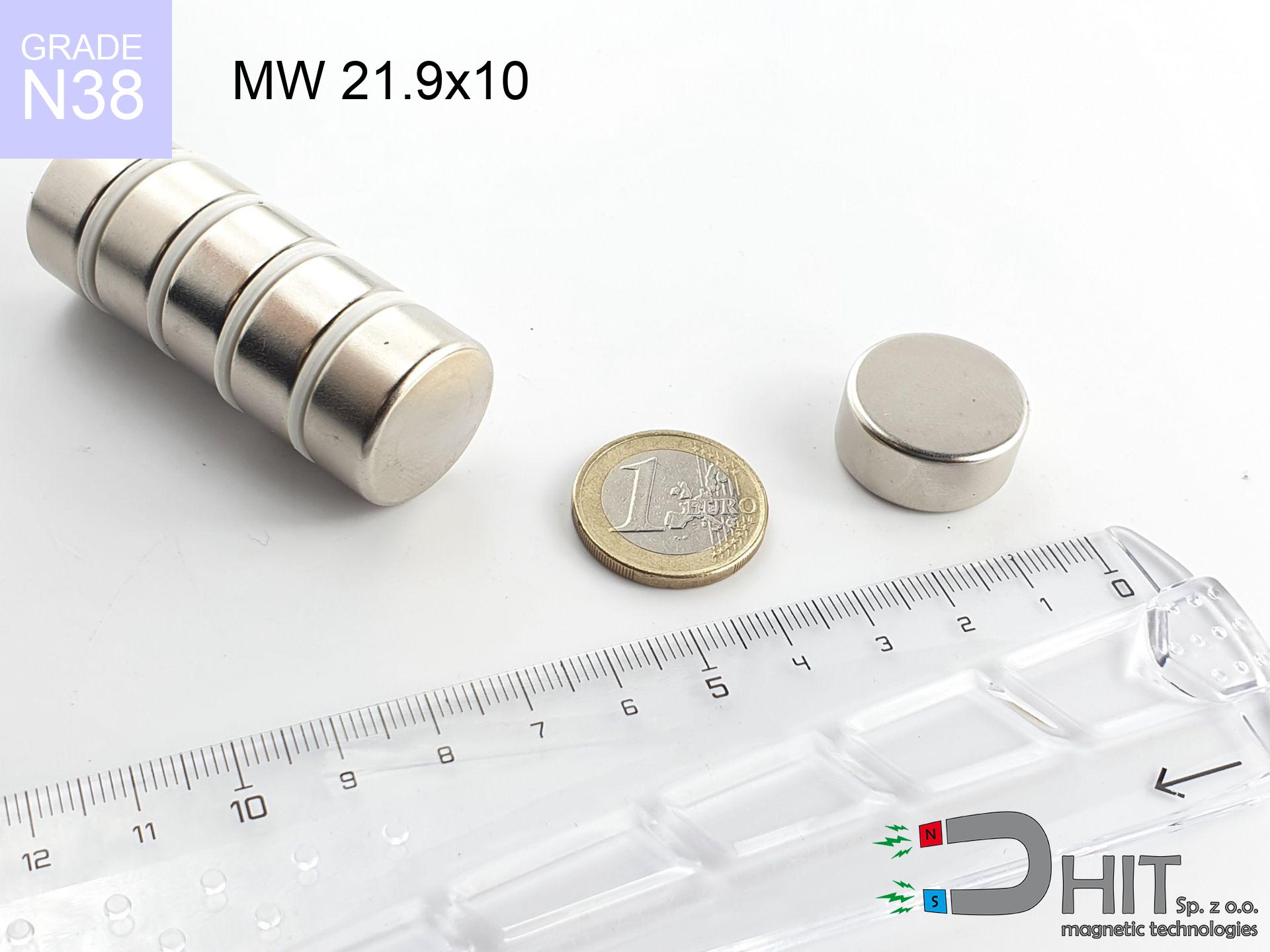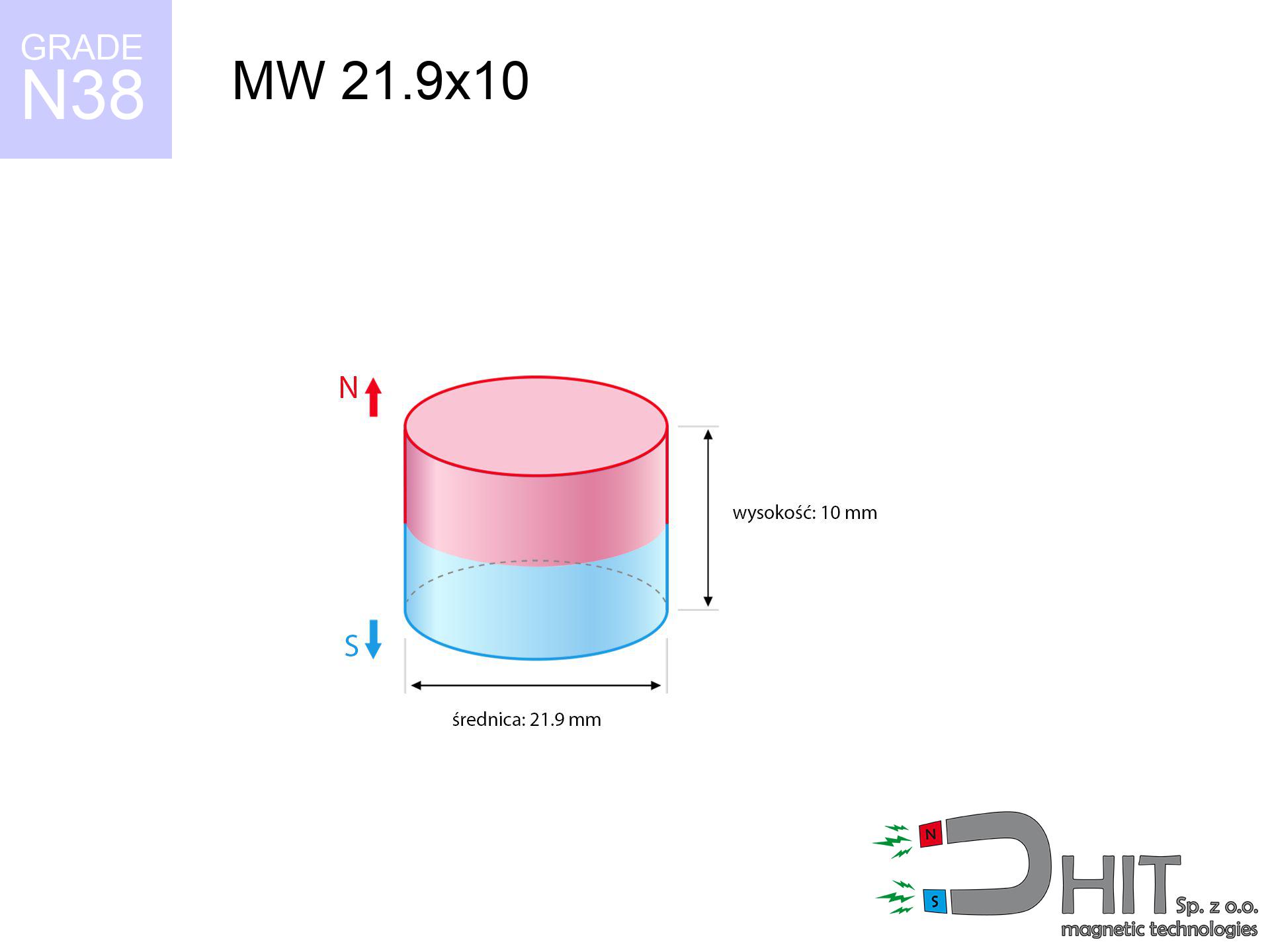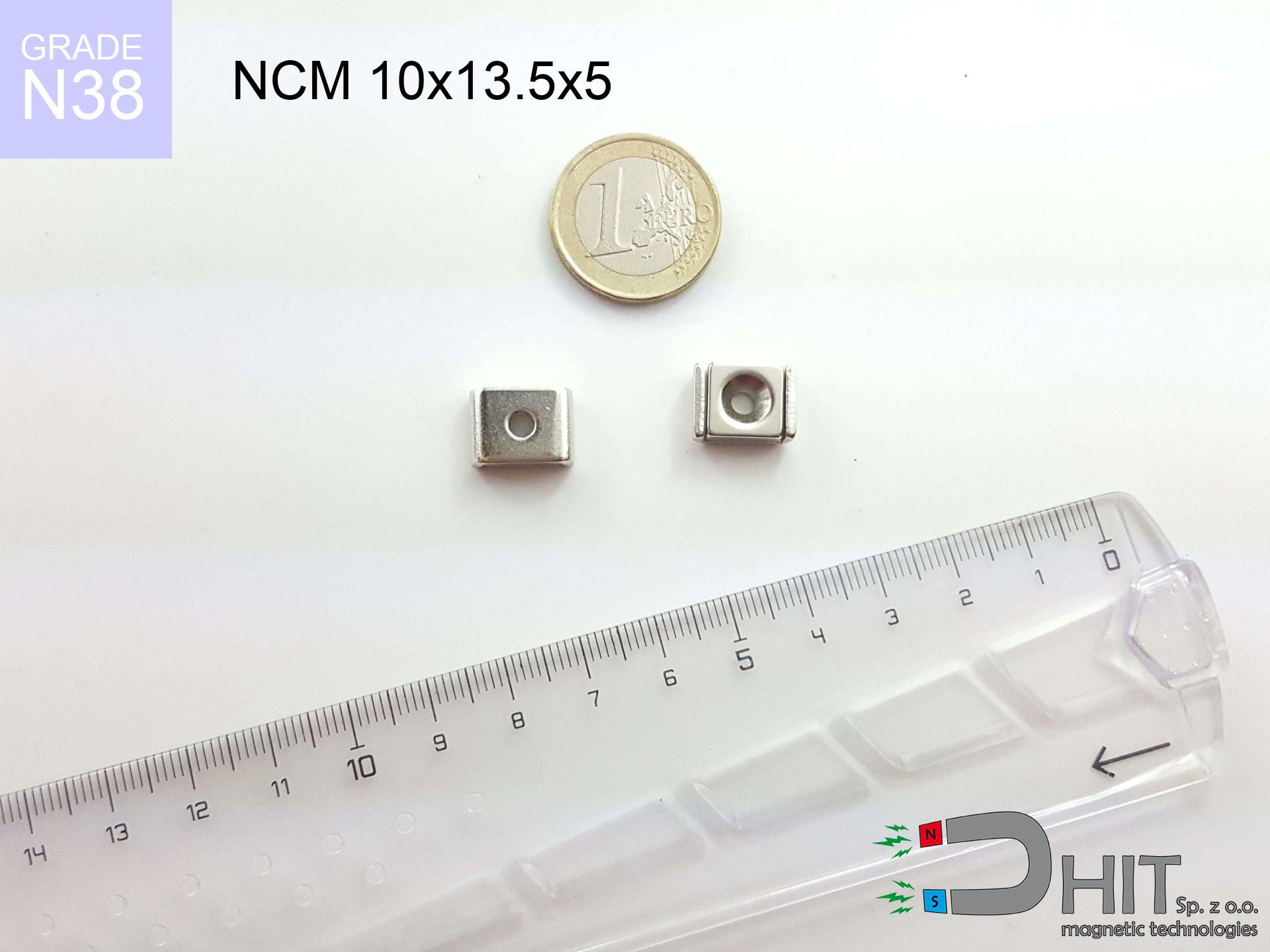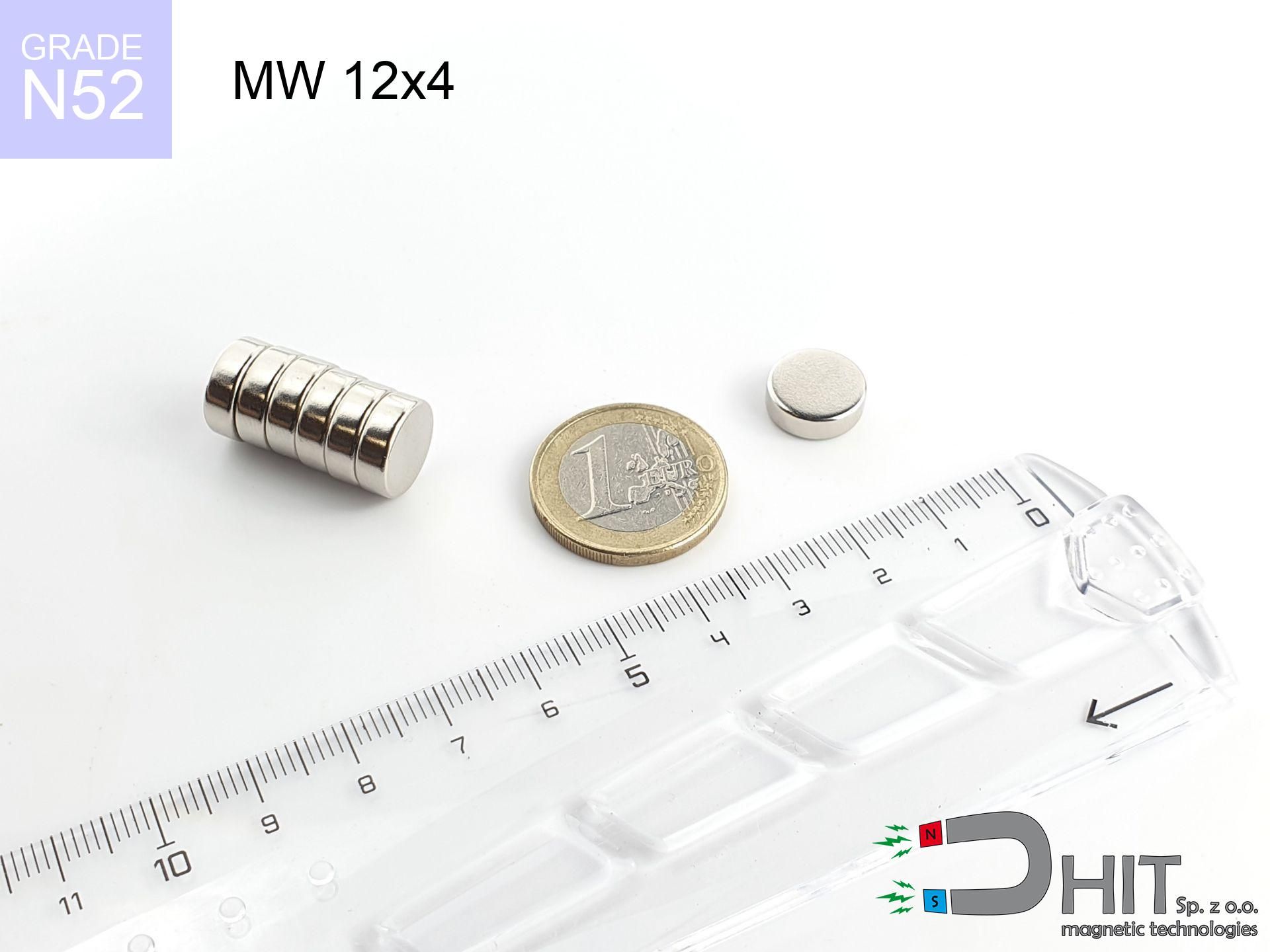MW 21.9x10 / N38 - cylindrical magnet
cylindrical magnet
Catalog no 010045
GTIN: 5906301810445
Diameter Ø
21.9 mm [±0,1 mm]
Height
10 mm [±0,1 mm]
Weight
28.25 g
Magnetization Direction
→ diametrical
Load capacity
13.83 kg / 135.65 N
Magnetic Induction
417.89 mT
Coating
[NiCuNi] nickel
15.50 ZŁ with VAT / pcs + price for transport
12.60 ZŁ net + 23% VAT / pcs
bulk discounts:
Need more?Looking for a better price?
Contact us by phone
+48 888 99 98 98
if you prefer contact us via
contact form
our website.
Weight and shape of a magnet can be checked using our
our magnetic calculator.
Same-day shipping for orders placed before 14:00.
Magnetic properties of material N38
Physical properties of sintered neodymium magnets Nd2Fe14B at 20°C
Shopping tips
Advantages and disadvantages of neodymium magnets.
Apart from their superior magnetic energy, neodymium magnets have these key benefits:
- They have constant strength, and over around ten years their performance decreases symbolically – ~1% (in testing),
- They are extremely resistant to demagnetization induced by presence of other magnetic fields,
- By using a shiny coating of silver, the element acquires an elegant look,
- The surface of neodymium magnets generates a intense magnetic field – this is a key feature,
- Thanks to resistance to high temperature, they are able to function (depending on the shape) even at temperatures up to 230°C and higher...
- Considering the possibility of precise forming and adaptation to unique requirements, magnetic components can be produced in a wide range of forms and dimensions, which amplifies use scope,
- Significant place in advanced technology sectors – they serve a role in computer drives, electric motors, medical equipment, also complex engineering applications.
- Compactness – despite small sizes they offer powerful magnetic field, making them ideal for precision applications
Disadvantages of NdFeB magnets:
- They are prone to damage upon heavy impacts. To avoid cracks, it is worth protecting magnets in a protective case. Such protection not only shields the magnet but also increases its resistance to damage
- When exposed to high temperature, neodymium magnets suffer a drop in strength. Often, when the temperature exceeds 80°C, their strength decreases (depending on the size and shape of the magnet). For those who need magnets for extreme conditions, we offer [AH] versions withstanding up to 230°C
- They rust in a humid environment - during use outdoors we suggest using waterproof magnets e.g. in rubber, plastic
- Limited ability of producing threads in the magnet and complex shapes - preferred is a housing - magnetic holder.
- Potential hazard to health – tiny shards of magnets pose a threat, in case of ingestion, which becomes key in the context of child safety. Furthermore, small components of these devices are able to disrupt the diagnostic process medical when they are in the body.
- Higher cost of purchase is one of the disadvantages compared to ceramic magnets, especially in budget applications
Maximum lifting force for a neodymium magnet – what contributes to it?
The force parameter is a theoretical maximum value conducted under specific, ideal conditions:
- using a base made of high-permeability steel, acting as a magnetic yoke
- whose transverse dimension is min. 10 mm
- characterized by even structure
- without the slightest clearance between the magnet and steel
- during detachment in a direction perpendicular to the mounting surface
- at room temperature
Determinants of practical lifting force of a magnet
Holding efficiency impacted by specific conditions, including (from priority):
- Distance (betwixt the magnet and the plate), since even a microscopic clearance (e.g. 0.5 mm) results in a decrease in lifting capacity by up to 50% (this also applies to paint, corrosion or dirt).
- Direction of force – maximum parameter is available only during perpendicular pulling. The resistance to sliding of the magnet along the plate is standardly several times smaller (approx. 1/5 of the lifting capacity).
- Metal thickness – the thinner the sheet, the weaker the hold. Magnetic flux passes through the material instead of generating force.
- Material composition – different alloys attracts identically. Alloy additives worsen the attraction effect.
- Plate texture – ground elements ensure maximum contact, which increases force. Rough surfaces reduce efficiency.
- Thermal conditions – neodymium magnets have a sensitivity to temperature. At higher temperatures they lose power, and at low temperatures they can be stronger (up to a certain limit).
* Holding force was checked on the plate surface of 20 mm thickness, when the force acted perpendicularly, whereas under attempts to slide the magnet the holding force is lower. Moreover, even a slight gap {between} the magnet’s surface and the plate reduces the holding force.
Safe handling of NdFeB magnets
Sensitization to coating
Allergy Notice: The Ni-Cu-Ni coating contains nickel. If an allergic reaction appears, cease working with magnets and wear gloves.
Electronic devices
Data protection: Strong magnets can ruin payment cards and sensitive devices (pacemakers, medical aids, timepieces).
Permanent damage
Regular neodymium magnets (N-type) undergo demagnetization when the temperature goes above 80°C. This process is irreversible.
ICD Warning
Medical warning: Strong magnets can turn off heart devices and defibrillators. Do not approach if you have medical devices.
Threat to navigation
A powerful magnetic field negatively affects the operation of compasses in phones and GPS navigation. Keep magnets close to a smartphone to avoid damaging the sensors.
Fire warning
Dust produced during cutting of magnets is flammable. Avoid drilling into magnets unless you are an expert.
Immense force
Handle with care. Rare earth magnets act from a distance and connect with huge force, often quicker than you can move away.
Serious injuries
Large magnets can break fingers instantly. Never put your hand between two attracting surfaces.
Material brittleness
Despite metallic appearance, the material is brittle and cannot withstand shocks. Do not hit, as the magnet may shatter into sharp, dangerous pieces.
No play value
Strictly store magnets away from children. Choking hazard is high, and the consequences of magnets connecting inside the body are tragic.
Warning!
Details about hazards in the article: Magnet Safety Guide.






![MPL 40x10x5x2[7/3.5] / N38 - lamellar magnet MPL 40x10x5x2[7/3.5] / N38 - lamellar magnet](https://cdn3.dhit.pl/graphics/products/mpl-40x10x5x27-3.5-miw.jpg)
![UMGZ 48x24x11.5 [M8] GZ / N38 - magnetic holder external thread UMGZ 48x24x11.5 [M8] GZ / N38 - magnetic holder external thread](https://cdn3.dhit.pl/graphics/products/umgw-48x24x11.5-m8-gz-bit.jpg)

